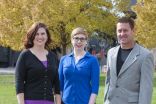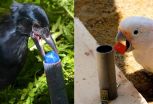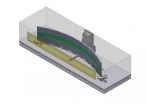Stanford scientist examines ways to put stormwater to use in big cities
2014-12-15
(Press-News.org) Runoff from rainstorms in big cities can represent both threats and opportunities. Too much runoff in the wrong places causes flooding. Too little rainwater in the right places leads to dried-up creeks and rivers. Water that washes up pollution from city streets can dirty downstream watersheds. Figuring out the best solutions to these problems requires lots of data - data that are easy to get in highly developed countries, but much scarcer in others.
On Dec. 15 at the American Geophysical Union Fall Meeting in San Francisco, Perrine Hamel, a postdoctoral scholar with the Stanford Woods Institute for the Environment, will speak on "Mapping Stormwater Retention in the Cities: A Flexible Model for Data-Scarce Environments." At 9 a.m. PT at the San Francisco Marriott Marquis, Salon 13-15, she will present work in progress to model the ecosystem and financial benefits of "natural capital," such as undisturbed watersheds or urban biofilters for managing stormwater.
"It's really trying to mimic what would happen in a natural watershed," said Perrine.
Initially, Perrine and co-author Bonnie Keeler from the University of Minnesota Institute on the Environment plan to study the data-rich Capitol Region watershed in St. Paul, Minnesota. Then they plan to extend that work to the data-poor settings of São Paulo, Brazil, and Addis Ababa, Ethiopia.
Their goal is to determine the value of stormwater retention services for large cities in developing countries, and to compare their benefits to those of other services like recreation or urban heat island mitigation. Natural Capital Project partners World Wildlife Fund and The Nature Conservancy want to help large cities like Addis Ababa develop in ways that enhance the provision of ecosystem services and that don't create future problems from stormwater runoff.
INFORMATION:
ELSE PRESS RELEASES FROM THIS DATE:
2014-12-15
Stanford scientists have found evidence that sections of the fault responsible for the 9.0 magnitude Tohoku earthquake that devastated northern Japan in 2011 were relieving seismic stress at a gradually accelerating rate for years before the quake.
This "decoupling" process, in which the edges of two tectonic plates that are frictionally locked together slowly became unstuck, transferred stress to adjacent sections that were still locked. As a result, the quake, which was the most powerful ever recorded to hit Japan, may have occurred earlier than it might have otherwise, ...
2014-12-15
WASHINGTON, Dec. 15, 2014--Credit card fraud and identify theft are serious problems for consumers and industries. Though corporations and individuals work to improve safeguards, it has become increasingly difficult to protect financial data and personal information from criminal activity. Fortunately, new insights into quantum physics may soon offer a solution.
As reported in The Optical Society's (OSA) new high-impact journal Optica, a team of researchers from the Netherlands has harnessed the power of quantum mechanics to create a fraud-proof method for authenticating ...
2014-12-15
A survey of more than 300 college students reveals that college students who use "fake weed" or synthetic THC are most likely to have tried the drug because they were curious. Rebecca Vidourek, a University of Cincinnati assistant professor of health promotion and assistant director of the Center for Prevention Science; Keith King, a UC professor of health promotion and director of the Center for Prevention Science; and Michelle Burbage, a graduate student and graduate assistant for UC's Health Promotion and Education Program, published their findings in the current issue ...
2014-12-15
This news release is available in French. "Media reports about behavioural genetics unintentionally induce unfounded beliefs, therefore going against the educational purpose of scientific reporting," writes the University of Montreal's Alexandre Morin-Chassé, following his study of 1,500 Americans. "Among other things, we wanted to know if the public understood (or misunderstood) popular science articles about a new research field, genopolitics, and whether this popularization indeed helped people have an informed opinion on human genetics," Morin-Chassé explained.
The ...
2014-12-15
This news release is available in German. The ways animals play with inedible objects may be precursors of functional behaviors such as tool use and goal directed object manipulation. For these reasons, species of high technical intelligence are also expected to play intensely with inanimate objects when no obvious goal is pursued. Within object play, combinatory actions are considered a particularly informative trait in animals as well as human infants: Children start bashing two objects together when they are about 8 months old, at 10 months, they combine toys with ...
2014-12-15
A study conducted by University of Granada scientists (from the Physiology, Obstetrics and Gynaecology Departments) and from the San Cecilio Clinical Hospital (Granada) has demonstrated that delaying the cutting of the umbilical cord in newborns by two minutes leads to a better development of the baby during the first days of life.
This multidisciplinary work, published in the prestigious journal Pediatrics reveals that the time in cutting the umbilical cord (also called umbilical cord clampling) influences the resistance to oxidative stress in newborns.
For this research, ...
2014-12-15
In medicine, X-rays provide high-resolution images of our insides to help doctors make a definitive diagnosis. Industry uses X-rays, too - as a reliable, non-destructive way of seeing what's hidden on inside materials and components and to check for cracks or irregularities. However industry additionally draws upon different technologies that are not used in the medical field. Whereas medical X-ray machines have been specifically designed for human test subjects, industrial X-ray machines are used to analyze objects that vary much more in their size and material composition. ...
2014-12-15
MANHASSET, NY -- Molecular Medicine, a peer-reviewed biomedical journal published by the Feinstein Institute Press, published the results of a new study reporting clinically significant pain reduction in type 2 diabetic patients. In an exploratory study conducted by Araim Pharmaceuticals, a biotech company developing novel treatments for chronic diseases, investigators also observed improvements in metabolic control in patients administered ARA 290. ARA 290 is a peptide engineered to activate the innate repair receptor, a receptor discovered by Araim scientists, which is ...
2014-12-15
Scientists at Johannes Gutenberg University Mainz (JGU) in Germany have discovered a new signal pathway in the brain that plays an important role in learning and the processing of sensory input. It was already known that distinct glial cells receive information from neurons. However, it was unknown that these same glial cells also transmit information to neurons. The glia release a specific protein fragment that influences neuronal cross-talk, most likely by binding to the synaptic contacts that neurons use for communication. Disruption of this information flow from the ...
2014-12-15
New research led by the University of Exeter has found that people who have a stronger sense of place at the global than the national level are more likely to accept that climate change is caused by human activities. This is the first time that acceptance of human causes of climate change has been shown to be linked to people's sense of place at the global level. The findings have significant implications both for climate change communications and for our understanding of place and identities.
The study 'My country or my planet? Exploring the influence of multiple place ...
LAST 30 PRESS RELEASES:
[Press-News.org] Stanford scientist examines ways to put stormwater to use in big cities



